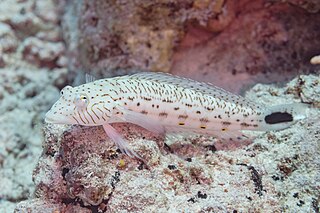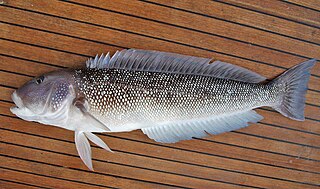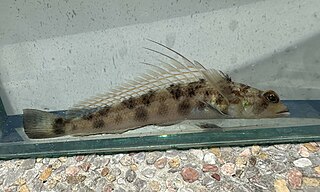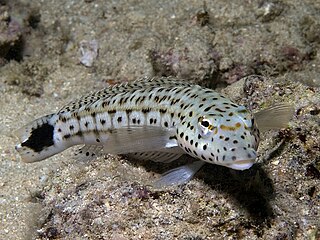
The sandperches are a family, Pinguipedidae, of fishes in the percomorph order Trachiniformes. Sandperches are benthic fish which normally occur over sand or rubble substrates in shallow seas. They are found off the coasts of South America, South Africa and in the Indo-Pacific as far east as Japan. The family contains a few species which are used by humans for food.

Parapercis is a genus of sandperches belonging to the family Pinguipedidae.

Parapercis hexophtalma, the speckled sandperch, is a species of marine ray-finned fish in the family Pinguipedidae, found in the western Indo-Pacific Ocean. It was first described by the French naturalist Georges Cuvier in 1829. There are several synonyms, some of which represent misspellings of the original name, and others which were given to female fish, at the time thought to be a separate species.

Kochichthys is a monotypic genus of percomorph fish from the family Pinguipedidae. The only species in the genus, Kochichthys flaviofasciatus, is found in the western Pacific in the waters around Japan, having been recorded only from Tosa Bay in Kōchi Prefecture on the island of Shikoku.

Pseudopercis is a genus of ray-finned fish which are part of the family Pinguipedidae, the sandperches. They are from the coastal waters of South America and are distinguished from other Neotropical sandperches in their more robust heads and bodies.
Ryukyupercis is a monotypic genus of percomorph fish from the family Pinguipedidae, the sandperches. The only species in the genus, Ryukyupercis gushikeni, the rosy grubfish, is found in the Indo-Pacific from Japan to north western Australia. The generic name is a compound of Ryukyu after the Ryukyu Islands where the type specimen was collected and "percis" a suffix for many of the genera in the Pinguipediae, the specific name honours Mr Soko Gushiken, a who gave the describer of the species, Tetsuo Yoshino, many specimens.
The threespine grubfish is the only species in the monotypic genus Simipercis, part of the family Pinguipedidae. The species is endemic to waters off eastern Australia from Swain Reefs, Queensland, to Broken Bay, New South Wales. It is distinguished from other sandperch by having three spines in the dorsal fin.

Pinguipes chilensis, commonly known as the Chilean sandperch, is a species of ray-finned fish in the family Pinguipedidae. It is found in the southeastern Pacific Ocean off the coasts of Peru and Chile.
Parapercis albipinna is a ray-finned fish species in the sandperch family, Pinguipedidae. It is found in New Caledonia. This species reaches a length of 14.2 cm (5.6 in).
Parapercis flavolineata, the yellowline sandperch, is a ray-finned fish species in the sandperch family, Pinguipedidae. It is found in Indonesia. This species reaches a length of 14.0 cm (5.5 in).
Parapercis shaoi is a ray-finned fish species in the sandperch family, Pinguipedidae. It is found in Taiwan. This species reaches a length of 15.3 cm (6.0 in).
Parapercis vittafrons, the bandhead sandperch, is a ray-finned fish species in the sandperch family, Pinguipedidae. It is found in Papua New Guinea. This species reaches a length of 9.0 cm (3.5 in).
Parapercis colemani is a ray-finned fish species in the sandperch family, Pinguipedidae. It is found at Norfolk Island.. This species reaches a length of 8.2 cm (3.2 in).
Parapercis lata, the y-barred sandperch, is a ray-finned fish species in the sandperch family, Pinguipedidae. It is found in the Eastern Central Pacific, Kiribati among other locations. This species reaches a length of 21.2 cm (8.3 in).
Parapercis dockinsi is a ray-finned fish species in the sandperch family, Pinguipedidae. It is found in the Southeastern Pacific and is believed to be endemic to Juan Fernández Island. This species reaches a length of 17.2 cm (6.8 in).

Parapercis filamentosa, the threadfin sandperch, is a species of ray-finned fish in the sandperch family, Pinguipedidae. It is found in the western Pacific Ocean including Hainan, China and south to Thailand and Indonesia.

Parapercis pacifica is a species of ray-finned fish in the sandperch family, Pinguipedidae. It is found in the western Pacific Ocean from southern Japan to Indonesia.

Parapercis queenslandica is a species of ray-finned fish in the sandperch family, Pinguipedidae. It is found in the western Pacific Ocean from Australia and New Caledonia.

Parapercis xanthogramma is a species of ray-finned fish in the sandperch family, Pinguipedidae. It is found in the central Pacific Ocean including Fiji, Western Samoa and Tonga.

Parapercis pulchella, the harlequin sandsmelt, is a ray-finned fish species in the sandperch family, Pinguipedidae. It is found in the north-western Pacific Ocean, including the shores of Japan, Taiwan and Hong Kong.











